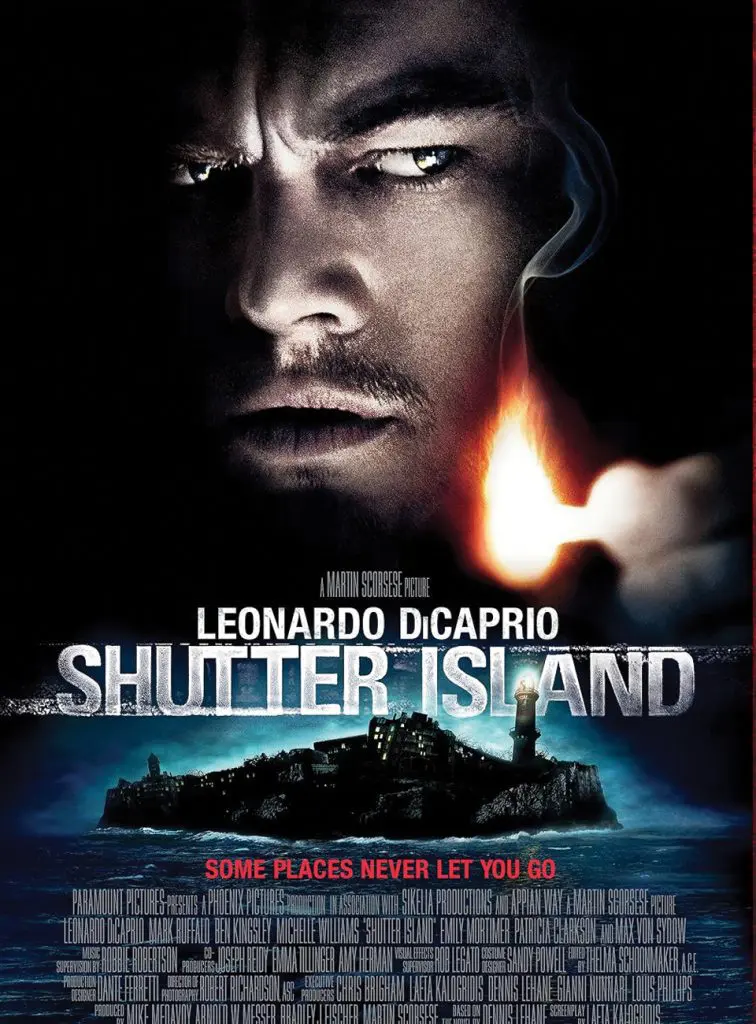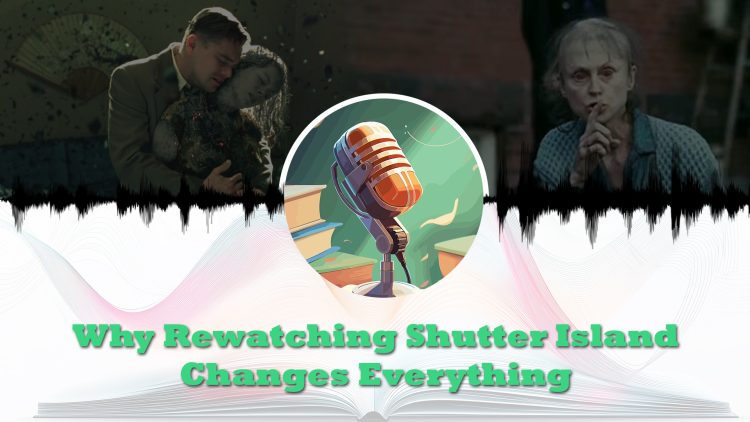We begin the podcast with Meaghan and Arthur playfully addressing the confusion brought on by a long weekend and busy schedules, setting a casual and conversational tone for the episode. They remind listeners that this is the last week of their series focused on unreliable narrators, tricksters, and deceptive perspectives in storytelling.
They recap their previous episode, where they explored the various kinds of unreliable narrators, ranging from innocent children to substance abusers, pathological liars, and mentally unstable individuals. The hosts stress that the term “unreliable narrator” is often used as a catch-all, but it actually encompasses a broad range of narrative techniques and psychological complexities.
Introducing Shutter Island and Its Origins

To build on the theme, they examine a well-known adaptation – Shutter Island, a 2010 book adaptation directed by Martin Scorsese and based on Dennis Lehane’s 2003 novel of the same name. They provide background on Lehane’s literary career, his recurring themes, and his reputation for gritty, Boston-based crime thrillers. His stories often feature morally complex characters and psychological twists. Other adaptations of his work include Mystic River, Gone Baby Gone, and Live by Night.
We learn that Lehane got the idea for Shutter Island after reading about psychological experiments in the 1950s, specifically post-World War II. The novel was intended as a tribute to Alfred Hitchcock, which helps explain its psychological tone and noir-style mystery. Meaghan and Arthur point out that while the film is visually distinct from Hitchcock’s style, the story shares similar thematic undercurrents, such as paranoia, identity, and trauma.
Dissecting the Plot and Narrative Mechanics

The hosts go on to recount the storyline of Shutter Island, set in 1954 and centered on U.S. Marshal Teddy Daniels (Leonardo DiCaprio) and his partner Chuck (Mark Ruffalo), who travel to a remote island to investigate the disappearance of Rachel Solando, a patient at a hospital for the criminally insane. Although the facility is heavily guarded and geographically isolated, Rachel appears to have vanished.
From the beginning, Meaghan and Arthur highlight how the film uses subtle cues to raise suspicion. The guards are overarmed, the staff is evasive, and files are withheld. Everything contributes to the sense that something is deeply wrong. DiCaprio’s character experiences disturbing dreams, hallucinations, and flashbacks to his military service during World War II, especially his role in liberating a concentration camp. These visions hint at trauma and establish Teddy as someone whose perception may not be entirely reliable.
As the narrative progresses, Teddy becomes increasingly convinced that the hospital is performing secret psychological experiments on patients and that the missing Rachel may be part of a larger conspiracy. Meaghan and Arthur note that these beliefs are intensified when Teddy finds a woman in a cave who claims to be the real Rachel Solando – a former psychiatrist who was institutionalized after uncovering illegal experiments.
The hosts express mixed feelings about this particular scene. Meaghan feels it is unnecessary and muddles the story, while Arthur argues that it reinforces the central theme: in an institution where authorities can label someone insane, any truth-teller can easily be discredited.
Enjoying this article?
Subscribe to our weekly newsletterThe Big Reveal and Thematic Weight
Eventually, the story builds to its climactic reveal: Teddy Daniels is actually Andrew Laeddis, a patient at the asylum. He was once a U.S. Marshal but suffered a complete psychological break after his wife, Dolores, killed their three children. In response, Andrew killed her and was institutionalized.
The entire investigation, including the missing patient and the conspiracy theories, was a therapeutic roleplay orchestrated by the facility’s staff in a desperate attempt to cure Andrew without resorting to a lobotomy. Mark Ruffalo’s character is revealed to be Dr. Lester Sheehan, Andrew’s primary psychiatrist. Ben Kingsley’s Dr. Cawley was overseeing the operation, hoping that by reenacting the narrative Andrew constructed, he might be able to confront reality and accept the truth.
Meaghan and Arthur analyze the storytelling methods used to reflect Andrew’s delusions. The use of water and fire imagery, disjointed conversations, and dream-like sequences all reinforce his fragile mental state. Arthur appreciates how the film mirrors the unreliable narration used in the book, where language and perspective conceal the truth until the very end.
RelatedBinge-Worthy Psychological Thriller Books With Shocking Twists
They also discuss how Andrew briefly regains lucidity, acknowledging what happened to his wife and children. However, in the final scene, he appears to relapse, again referring to Chuck as his partner and insisting they need to “get off the island.”
Meaghan suggests that this might be a conscious choice – Andrew possibly pretends to have relapsed to avoid living with the overwhelming pain of his past. His final line supports this interpretation.
Which would be worse: to live as a monster, or to die as a good man?
This final twist was not part of the book but was added during filming. Both hosts agree it deepens the emotional impact of the story and elevates the film’s ending.
Reflections on the Film and Comparisons to Other Works

The hosts have a nuanced discussion on their personal responses to the film. Arthur enjoys Shutter Island for its suspense and atmosphere, while Meaghan admits she found it predictable, having guessed the twist early on during her first viewing. She expresses frustration that knowing the reveal made the film drag for her, given its lengthy runtime and misleading scenes that felt unnecessary.
Still, both agree that Shutter Island benefits from rewatching. Knowing the ending allows viewers to pick up on subtle cues and better appreciate the layered performances, particularly DiCaprio’s emotionally intense portrayal of Andrew.
RelatedForget Literary Fiction – Here’s Why Readers Can’t Resist Popcorn Thrillers
They also compare Shutter Island to other media that use unreliable narrators, such as American Psycho, Mystic River, and Gone Baby Gone. They find American Psycho especially effective, as it leaves viewers permanently unsure of what is real.
Meaghan shares that Leonardo DiCaprio reportedly experienced nightmares while filming due to the emotional toll of the role, and they admire his dedication to playing such a psychologically demanding character.
Reading Recommendations and Final Thoughts

To wrap up the episode, the hosts offer several book recommendations for those interested in similarly themed stories:
- The Silent Patient by Alex Michaelides: A psychological thriller involving a psychiatrist trying to understand a patient who has refused to speak since allegedly killing her husband.
- We Were Liars by E. Lockhart: A young adult novel about a privileged teen with amnesia after an accident. Meaghan admits she didn’t enjoy it, mainly because she predicted the twist and disliked the poetic prose style.
- Behind Her Eyes by Sarah Pinborough: A domestic thriller that morphs into psychological horror, famous for its divisive and unexpected ending.The Silent Patient by Alex Michaelides: A psychological thriller involving a psychiatrist trying to understand a patient who has refused to speak since allegedly killing her husband.
RelatedUnreliable Narrators, Twisted Truths: Why We Love Being Fooled in Books
They encourage listeners to revisit Shutter Island with fresh eyes, particularly to appreciate its themes, symbolism, and how its structure embodies the unreliable narrator technique. The episode ends with a teaser for next week’s content and hints at surprises coming in May.













